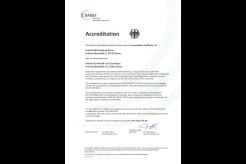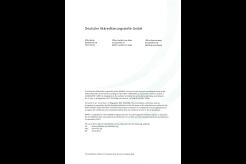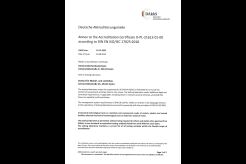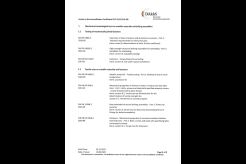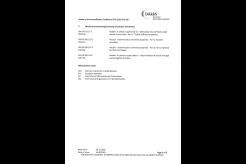Services accredited area
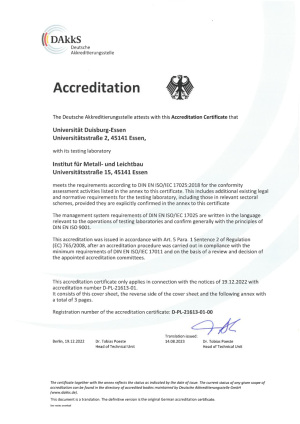
The Institute for Metal and Lightweight Structures is a testing laboratory accredited by the Deutsche Akkreditierungsstelle GmbH (DakkS) according to DIN EN ISO/IEC 17025. The accreditation is valid for the scope of accreditation listed in the annex of the certificate [D-PL-21613-01-00], which is listed below.
The Institute for Metal and Lightweight Structures is listed with the reference number D-PL-21613-01 in the register of testing laboratories in the field of building products/construction.
The laboratory managers of the accredited area are Dr.-Ing. Dominik Jungbluth for the competence area of steel construction and Dr.-Ing. Jörg Uhlemann for the competence area membrane construction.
The laboratory examinations/testing in the accredited area are carried out in the Essen Laboratory for Steel Construction (ELSta) or in the Essen Laboratory for Lightweight Structures (ELLF), depending on the standard.
For further information or if you are interested in activities from the accredited area, please contact Dr.-Ing. Dominik Jungbluth or Dr.-Ing. Jörg Uhlemann directly.
| List of standards in the accredited laboratory section* | ||||
|
Standard / Issue date; |
Title of the standard or in-house procedure (specify deviations / modifications from standard procedures, if applicable) |
Test object / inspection object | ||
| Testing of mechanically joined connections | ||||
| DIN EN 1090-2:2018-09, Annex G |
Execution of steel structures and aluminium structures - Part 2: Technical requirements for steel structures; German version EN 1090-2:2018 | Determining the static friction coefficient | ||
| DIN EN 14399-2:2015-04 Section 6 |
High-strength structural bolting assemblies for preloading - Part 2: Suitability for preloading; German version EN 14399-2:2015 | Suitability test on high-strength preloadable fittings | ||
| DIN EN ISO 16047:2013-01 Section 9 |
Fasteners - Torque/clamp force testing (ISO 16047:2005 + Amd 1:2012); German version EN ISO 16047:2005 + A1:2012 | Torque/preload test | ||
| Tensile tests on metallic materials and fasteners | ||||
| DIN EN ISO 6892-1:2020-06 Procedure B |
Metallic materials - Tensile testing - Part 1: Method of test at room temperature (ISO 6892-1:2019); German version EN ISO 6892-1:2019 | Tensile test on steel specimens | ||
| DIN EN ISO 898-1:2013-05 Section 9.2 & 9.7 |
Mechanical properties of fasteners made of carbon steel and alloy steel - Part 1: Bolts, screws and studs with specified property classes - Coarse thread and fine pitch thread (ISO 898-1:2013); German version EN ISO 898-1:2013 | Tensile test on carbon steel bolts & on machined specimens | ||
| DIN EN 15048-2:2016-09 Section 6 |
Non-preloaded structural bolting assemblies - Part 2: Fitness for purpose; German version EN 15048-2:2016 | Tensile test on fittings for bolted joints | ||
| DIN EN ISO 3506-1:2020-08 Section 9.1 |
Fasteners - Mechanical properties of corrosion-resistant stainless steel fasteners - Part 1: Bolts, screws and studs with specified grades and property classes (ISO 3506-1:2020); German version EN ISO 3506-1:2020 | Tensile test for fasteners | ||
| Mechanical-technological testing of plastics and textiles | ||||
| DIN EN 17117-1:2019-02 | Rubber or plastics-coated fabrics - Mechanical test methods under biaxial stress states - Part 1: Tensile stiffness properties; German version EN 17117-1:2018 | Biaxial tensile test on coated textiles | ||
| DIN EN ISO 527-1:2019-12 | Plastics - Determination of tensile properties - Part 1: General principles (ISO 527-1:2019); German version EN ISO 527-1:2019 | Tensile test foils | ||
| DIN EN ISO 527-3:2019-02 |
Plastics - Determination of tensile properties - Part 3: Test conditions for films and sheets (ISO 527-3:2018); German version EN ISO 527-3:2018; |
Tensile test foils | ||
| DIN EN ISO 1421:2017-03 | Rubber- or plastics-coated fabrics - Determination of tensile strength and elongation at break (ISO 1421:2016); German version EN ISO 1421:2016 | Monoaxial tensile test on coated textiles | ||
| DIN EN ISO 1421:1998-08 | Rubber- or plastics-coated fabrics - Determination of tensile strength and elongation at break (ISO 1421:1998); German version EN ISO 1421:1998 | Monoaxial tensile test on coated textiles | ||
*All test standards in the accredited section are subject to the flexibilised accreditation category A.
Uncertainties of measurement
Uncertainties of measurement are determined and communicated on request.
Statements on conformity assessment
Conformity statements are agreed with you as our customer and documented in the test protocols.
For simplification, we stipulate:
- If a decision rule is laid down in standards or specifications of the tests to be performed, these are deemed to be agreed with you.
- If you require a different decision rule or your own requirement for the test result, please inform us of this in writing when making the order inquiry and/or placing the order.
If there are no other specifications in the respective test standard or on the part of the customer, the following decision rule is used to assess conformity.
- Case 1: If a minimum value is specified:
a. If the minimum value is a mean value (e.g. from manufacturer's data sheet), the test is considered passed if the mean value of the test series is equal to or
greater than the minimum value, or failed if it is less than the minimum value.
b. If the minimum value is a 5% fractile value (e.g. from static calculation), the test is considered passed if the 5% fractile value of the test series according to
DIN EN 1990:2010 Annex D.7 for unknown coefficient of variation is equal to or greater than the minimum value, or failed if it is less than the minimum
value. - Case 2: If a limit interval is specified, the test is considered passed if the individual values are within the limit interval or are at one of the limit values.
Please also note that in all of the above cases, our measurement uncertainties are not taken into account in the conformity statements.
To further explain our decision rules, here are a few examples from practice:
- Example for case 1: Minimum tensile strengths are regularly required for tensile tests in membrane and steel construction. Decision rule 1 is used here.
- Example of case 2: Bandwidths with minimum and maximum values for coefficients of friction are regularly required when testing pre-tensioned bolted joints. Decision rule 2 is used here.

